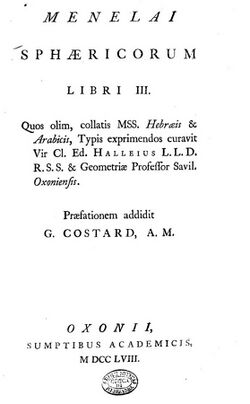Menelaus of Alexandria
Topic: Biography
 From HandWiki - Reading time: 3 min
From HandWiki - Reading time: 3 min
Menelaus of Alexandria (/ˌmɛnɪˈleɪəs/; Greek: Μενέλαος ὁ Ἀλεξανδρεύς, Menelaos ho Alexandreus; c. 70 – 140 CE) was a Greek[1] mathematician and astronomer, the first to recognize geodesics on a curved surface as natural analogs of straight lines.
Life and works
Although very little is known about Menelaus's life, it is supposed that he lived in Rome, where he probably moved after having spent his youth in Alexandria. He was called Menelaus of Alexandria by both Pappus of Alexandria and Proclus, and a conversation of his with Lucius, held in Rome, is recorded by Plutarch.
Ptolemy (2nd century CE) also mentions, in his work Almagest (VII.3), two astronomical observations made by Menelaus in Rome in January of the year 98. These were occultations of the stars Spica and Beta Scorpii by the moon, a few nights apart. Ptolemy used these observations to confirm precession of the equinoxes, a phenomenon that had been discovered by Hipparchus in the 2nd century BCE.
In the 10th-century Kitāb al-Fihrist [The Book Catalogue] by Ibn al-Nadīm, six books by Menelaus are mentioned: the Book of Spherical Propositions (Sphaerica), On the Knowledge of the Weights and Distribution of Different Bodies, The Elements of Geometry in three books, and The Book on the Triangle.[2] Only the first of these, Sphaerica, survives today in Arabic translation. Composed of three books, it deals with the geometry of the sphere and its application in astronomical measurements and calculations. The book introduces the concept of spherical triangle (figures formed of three great circle arcs, which he named "trilaterals") and proves Menelaus' theorem on collinearity of points on the edges of a triangle (which may have been previously known) and its analog for spherical triangles. It was later translated by the sixteenth century astronomer and mathematician Francesco Maurolico.
The lunar crater Menelaus is named after him.
Bibliography
The titles of a few books by Menelaus have been preserved:
- On the calculation of the chords in a circle, composed of six books
- Elements of geometry, composed of three books, later edited by Thabit ibn Qurra
- On the knowledge of the weights and distributions of different bodies
- He may also have written a star catalogue.
Notes
- ↑ Encyclopædia Britannica "Greek mathematician and astronomer who first conceived and defined a spherical triangle (a triangle formed by three arcs of great circles on the surface of a sphere)."
- ↑ Mayers, Kenneth (2014). "Menelaus of Alexandria". Biographical Encyclopedia of Astronomers. Springer. doi:10.1007/978-1-4419-9917-7_938.
References
- Ivor Bulmer-Thomas. "Menelaus of Alexandria." Dictionary of Scientific Biography 9:296-302.
- Pedro Pablo Fuentes González, “Ménélaos d’Alexandrie”, in R. Goulet (ed.), Dictionnaire des Philosophes Antiques, vol. IV, Paris, CNRS, 2005, p. 456-464.
- Roshdi Rashed and Athanase Papadopoulos, Menelaus' Spherics. Early Translation and al-Māhānī / al-Harawī's Version. De Gruyter, Scientia Graeco-Arabica 21. xiv, 874 pages. ISBN:978-3-11-056987-2
External links
- O'Connor, John J.; Robertson, Edmund F., "Menelaus of Alexandria", MacTutor History of Mathematics archive, University of St Andrews, http://www-history.mcs.st-andrews.ac.uk/Biographies/Menelaus.html.
- Halley's Latin Translation from the Arabic and Hebrew Versions (three books) at Google Books
- Google Books scan of the Sphaerica at wilbourhall.org
 |
 KSF
KSF
